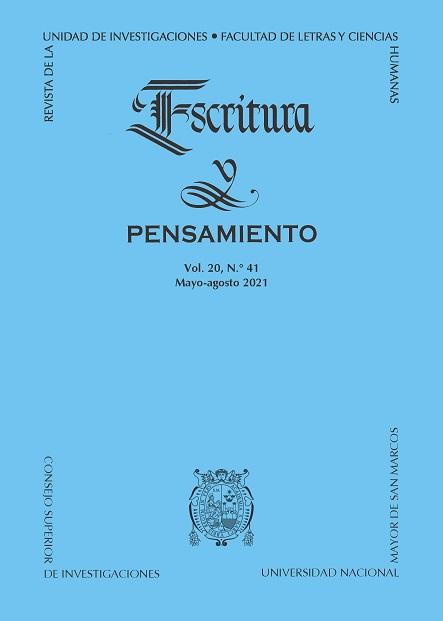The poetics of cultural germination or the representation of the andean subject from the paratextual elements in Falo (1926)
DOI:
https://doi.org/10.15381/escrypensam.v20i41.21111Keywords:
paratexts, lyrical andean subject, hegemonic subject, lyrical voice, cultural germinationAbstract
The Peruvian literary avant-garde was characterized by constructing a revulsive discourse that questioned the government apparatus and the hegemonic discourses of its time. In the collection of poems Falo (1926) by the poet from Puno Emilio Armaza (1902-1980), this mechanism is perceived in two instances. On the one hand, from the representation of an Andean lyrical subject, it seeks to annul the condition of the indigenous object because his figure takes center stage within the cultural scene. In turn, on the basis of a dialectical dynamic, it comes into tension with the hegemonic subjects. On the other hand, by making their cultural practices visible and conceiving them in constant germination, it establishes a form of cultural resistance against the symbolic and factual violence exercised against them. Through the analysis of the paratexs we will seek to demonstrate that this poetic strategy that Armaza executes pursues the objective of restoring the human condition of the Andean man and legitimizing the universality of his culture.
References
Angenot, M. (2010). El discurso social: los límites históricos de lo pensable y lo decible. Buenos Aires: Siglo XXI.
Armaza, E. (1926). Falo. Puno: Tipografía “Comercial”.
Bueno, R. (1985). Poesía hispanoamericana de vanguardia. Procedimientos de interpretación textual. Lima: Latinoamericana Editores.
Burga, M. & Flores Galindo, A. (1987). Apogeo y crisis de la República Aristocrática. Lima: Rikchay.
Chueca, L., (comp.). (2009). Poesía vanguardista peruana. Lima: Pontificia Universidad Católica del Perú.
García-Bedoya Maguiña, C. (1990). Para una periodización de la literatura peruana. Lima: Fondo Editorial de la Universidad Nacional Mayor de San Marcos.
Lauer, M. (2001a). 9 libros vanguardistas. Lima: El Virrey-OECI.
Lauer, M. (2001b). La Polémica del Vanguardismo 1916 - 1928. Lima: Fondo Editorial de la UNMSM.
Lauer, M. (2002). Poesía Vanguardista Peruana 1916 - 1930. Lima: Hueso Húmero Ediciones.
Lauer, M. (2003). Musa mecánica. Máquinas y poesía en la vanguardia peruana. Lima: Instituto de Estudios Peruanos.
Mamani, M. (2009). Poéticas andinas. Lima: Pájaro de Fuego Ediciones, Instituto de Investigaciones Humanísticas de la Facultad de Letras y Ciencias Humanas, Guaraguao.
Mamani, M. (2016). La poética de lo sensible. Lima: Fondo Editorial USIL.
Mamani, M. (2017). Sitio en la tierra. Antología del vanguardismo andino. Lima: Fondo de Cultura Económica.
Mignolo, W. (1982). La figura del poeta en la lírica de vanguardia. Revista Iberoamericana, 48 (118-119), 131-148. <https://core.ac.uk/download/pdf/296296269.pdf>
Ortiz, M. (2019). Poesía peruana de los años veinte: vanguardia e indigenismo. En R. Chang-Rodríguez & M. Velázquez (Drs.) Historia de las Literaturas en el Perú. Lima: PUCP, Casa de la Literatura Peruana, MINEDU.
Osorio, N. (1981). Para una caracterización del vanguardismo hispanoamericano. Revista Iberoamericana, 42 (114-115), 227-254. <https://revista-iberoamericana.pitt.edu/ojs/index.php/Iberoamericana/article/view/3623>
Sánchez, L. A. (1987). Valdelomar o la “belle époque”. Lima: Inpropesa.
Downloads
Published
Issue
Section
License
Copyright (c) 2021 Alex Díaz Vargas

This work is licensed under a Creative Commons Attribution 4.0 International License.
AUTHORS RETAIN THEIR RIGHTS:
a. The authors retain their trademark and patent rights, and also over any process or procedure described in the article.
b. The authors retain the right to share, copy, distribute, execute and publicly communicate the article published in the Escritura y Pensamiento (for example, place it in an institutional repository or publish as part a book), with acknowledgment of its initial publication by Escritura y Pensamiento.
c. Authors retain the right to make a subsequent publication of their work, to use the article or any part of it (for example: a compilation of their work, lecture notes, thesis, or for a book), provided that they indicate the source of publication (authors of the work, journal, volume, number and date).





